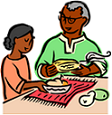Today we’re going to learn another great conversational phrase, we’re going to see how to ask the question ‘How old are you?’ and obviously this is no good if we don’t know how to reply so we’ll also see how to reply with ‘I am ____ years old’ in Hindi! So are you ready to get straight into it? I’ll show you it first then take you through what each of the words mean! Here goes…
 आपकी उम्र क्या है? aapkee umr kyaa hai
आपकी उम्र क्या है? aapkee umr kyaa hai
-How Old are You?
This is the same when asking both males and females. Have you got it? Say it out loud. Read it again -
आपकी उम्र क्या है? aapkee umr kyaa hai -How old are you? This you can remember it with enough practice?
So what are all these words here? Well let’s go through them!
Firstly we have
आपकी aapkee - This means ‘your’ . The next word is
उम्र umr - This (perhaps you’ve already guessed!) means ‘age’ and it’s feminine. So this is the reason we have to say
आपकी aapkee and
not आपका aapkaa

Hopefully you’re not too confused about this!
The next word is
कया kya. Can you remember what this means? We’ve seen it a few times already. Remember? That’s right, it means ‘what?’. And then finally we have
है hai which again, we’ve seen plently of times, it means ‘is’ .
Have you got it? Can you understand the phrase now?
आपकी उम्र कया है? aapkee umr kyaa hai -How old are you? Or, literally ‘Your age what is?’.
Now obviously the next this we want to know is how to reply with ‘I am ___ years old’. So are you ready to learn that?
अच्छा acchaa Great! This is where it becaomes different for males and females…
If you are a male you say…
 मैं __ साल का हूँ main ___ saal kaa hoon
मैं __ साल का हूँ main ___ saal kaa hoon
- I am __ years old (Said my a Male)
And if you are a female you say…
 मैं __ साल की हूँ main ___ saal kee hoon
मैं __ साल की हूँ main ___ saal kee hoon
- I am __ years old (Said by a Female)
Can you see the difference? A male uses the word
का kaa and a female uses the word
की kee! Obviously, you simply replace the gap with your age!
So for example a 10 year old boy would say…
 मैं दस साल का हूँ main das saal kaa hoon
मैं दस साल का हूँ main das saal kaa hoon
- I am ten years old (Said by a Male)
And a twenty year old Woman would say…
 मैं बीस साल की हूँ main bees saal kee hoon
मैं बीस साल की हूँ main bees saal kee hoon
-I am twenty years old (Said by a Female)







 भारत
भारत 
 अमेरिका
अमेरिका 
 चीन
चीन 










